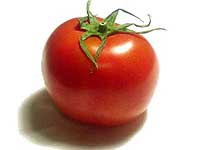
This guide describes and illustrates the most common tomato diseases encountered in Georgia home gardens. Growing tomatoes in Georgia is challenging because of the hot, humid summers and the potential for several diseases. Disease identification based on comparison with images often is not sufficient for an accurate diagnosis, especially when planning treatments. Before treatment, obtain a confirmation of the problem and a recommendation from your county Extension office.
Foliar and Fruit Diseases
Early Blight
Causal agent: Alternaria solani
Symptoms
Early blight can occur on all parts of the plant except the roots, although leaf infections usually are the most damaging. The older foliage near the ground shows the first symptoms (small brown or black spots). Often, a yellow halo surrounds the spot. As the spots enlarge, the shape becomes irregular, and concentric rings develop within the lesion (Figure 1). As the damage progresses up the plant, the lowest leaves turn brown and drop from the plant (Figure 2), although fruit production continues. If conditions for disease remain favorable, production declines and eventually only a few green leaves remain at the top of the plant.
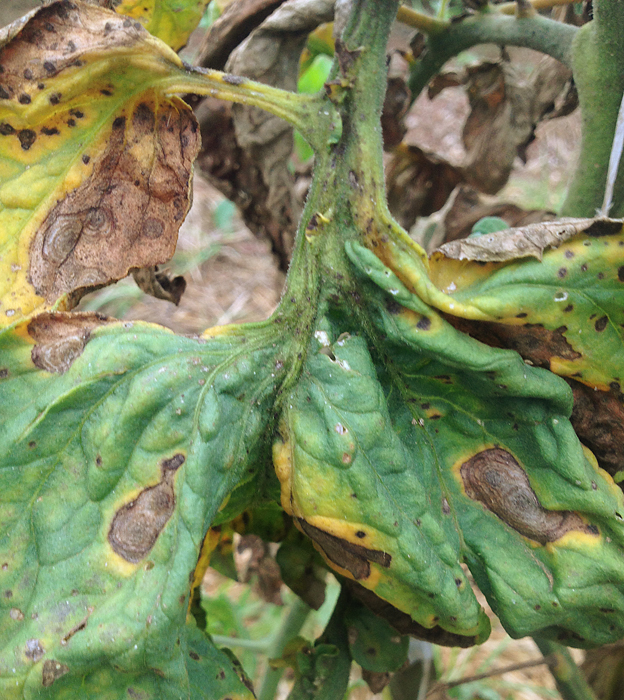 Figure 1. Early blight (Alternaria solani). Note large irregular brown lesions with concentric circles of growth.
Figure 1. Early blight (Alternaria solani). Note large irregular brown lesions with concentric circles of growth.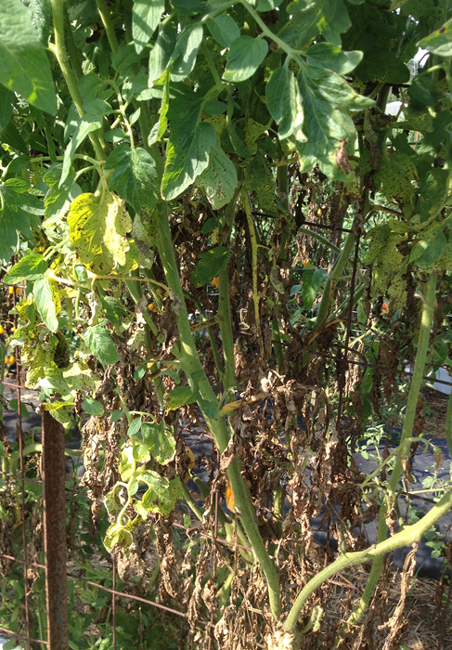 Figure 2. Leaf spot disease damage on tomato. Disease and leaf death start at the bottom of a plant and progress up the plant until most leaves are blighted.
Figure 2. Leaf spot disease damage on tomato. Disease and leaf death start at the bottom of a plant and progress up the plant until most leaves are blighted.Favorable Conditions
The fungal pathogen survives on infected debris left in the field but also can be carried on seed. Infection occurs during rainy, warm conditions. Although 75 to 84 °F is optimal, the disease may be active at higher temperatures. Heavy dews and rains increase disease spread and development.
Septoria Leaf Spot
Causal agent: Septoria lycopersici
Symptoms
The first symptoms usually appear on the lower leaves after the first fruit sets. The spots are smaller than early blight lesions, and more circular, with tan to gray centers and dark margins (Figure 3). The pattern of infection and leaf loss is like early blight, and the two diseases can occur together. If the infection is severe, leaves will turn brown starting with the oldest foliage at the bottom. The fruit is not infected.
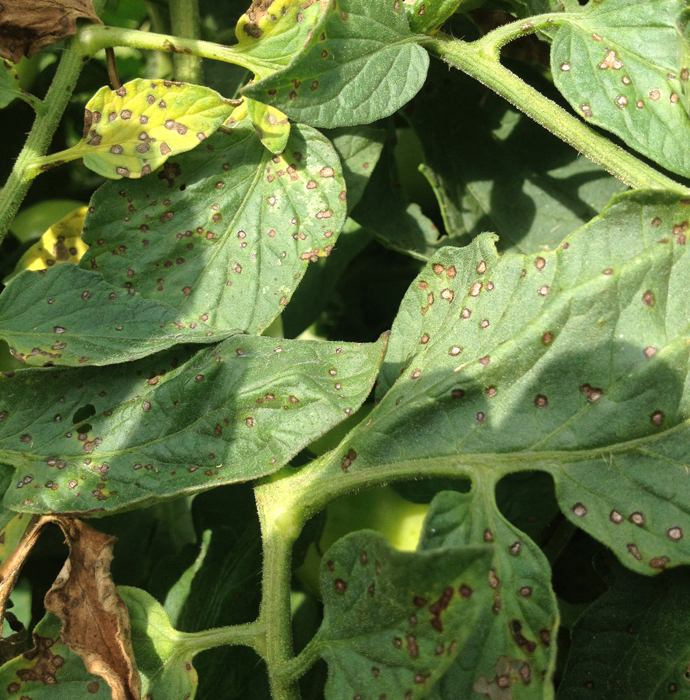 Figure 3. Septoria leaf spot. Note numerous small spots with gray centers.
Figure 3. Septoria leaf spot. Note numerous small spots with gray centers.Favorable Conditions
Septoria survives on infected plant debris, weed hosts, and seed. Rain and overhead irrigation move the spores within and between plants. Movement by people when the foliage is wet also can spread the pathogen. Compared to early blight, Septoria infects at slightly cooler temperatures (68 to 77 °F). Septoria leaf spot can spread quickly during extended wet conditions.
Bacterial Spot
Causal agents: Xanthomonas euvesicatoria, X. gardneri, X. performans, X. vesicatoria
Symptoms
Bacterial spot affects stems, petioles, leaves, and fruit. Spots are dark brown to black and often are angular in shape (Figure 4). The disease may be confused with early blight although there are no concentric rings in the lesions and no yellow halo around the lesion. When infection is severe, the foliage yellows and dies. The disease is more common in South Georgia, although it may occur in North Georgia during extended wet periods. The disease is often more severe on peppers when conditions are wet.
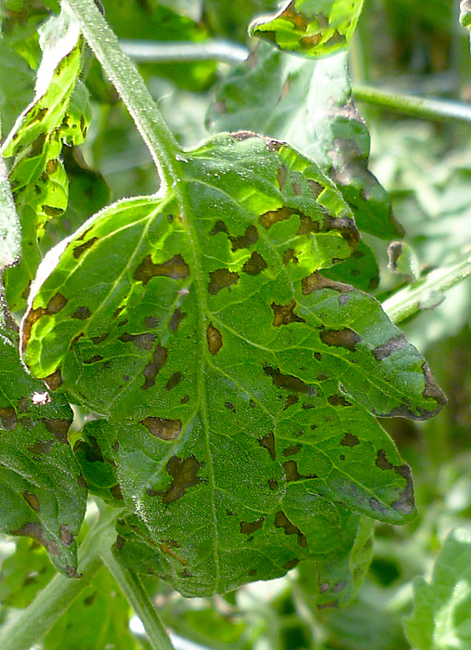 Figure 4. Bacterial leaf spot (Xanthomonas spp.) on tomato. Lesions are dark and often angular instead of round.
Figure 4. Bacterial leaf spot (Xanthomonas spp.) on tomato. Lesions are dark and often angular instead of round.Favorable Conditions
Bacterial spot can survive on infected plants, plant debris, and seed. The bacterium reproduces, spreads, and infects during wet weather and prefers temperatures between 75 and 86 °F. The bacterium moves from plant to plant with rain, workers, and tools.
Leaf Mold
Causal agent: Fulvia fulva (syn: Passalora fulva, Cladosporium fulvum)
Symptoms
Leaf mold is distinctive from other tomato leaf spot diseases in that the top of the leaf develops distinct irregular-shaped yellow spots (Figure 5) while the underside has a thick, fuzzy, brown carpet of fungal spores (Figure 6). As with most leaf spot diseases, spotting and defoliation usually start at the bottom of the plant and progress upward.
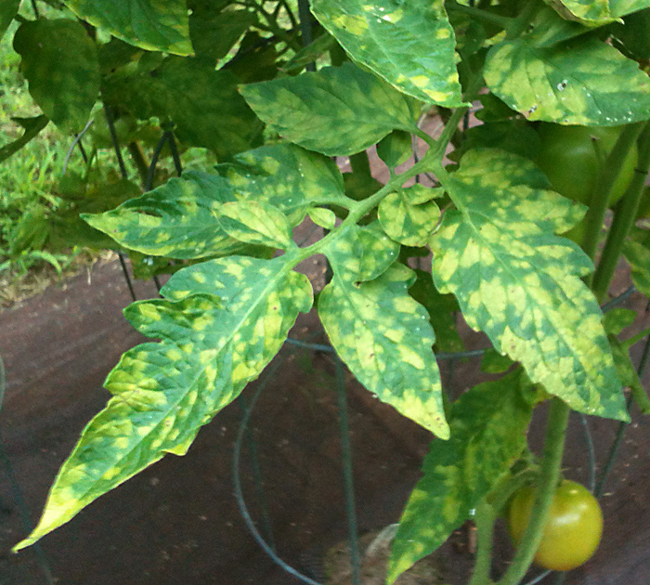 Figure 5. Leaf mold (Fulvia fulva) symptoms on top of a leaf. Note yellow patches.
Figure 5. Leaf mold (Fulvia fulva) symptoms on top of a leaf. Note yellow patches.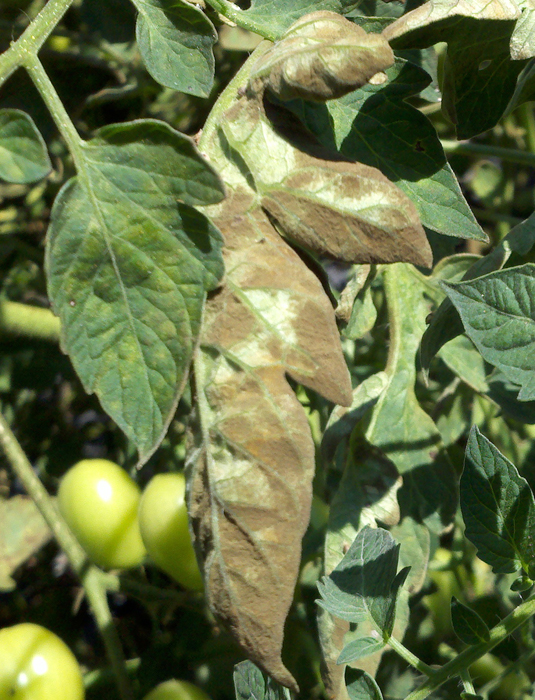 Figure 6. Dense, brown spores of the leaf mold pathogen on the underside of lesions. Spores are visible to the naked eye.
Figure 6. Dense, brown spores of the leaf mold pathogen on the underside of lesions. Spores are visible to the naked eye.Favorable Conditions
The leaf mold pathogen spreads and infects during periods of high relative humidity (> 90%) but does not necessarily need rain. The optimum temperature range is from 70 to 80 °F. Greenhouses and high tunnels most often satisfy these conditions although the disease will appear in tomatoes grown outside in areas with low light and/or poor air circulation.
Buckeye Rot
Causal agent: Phytophthora parasitica, P. capsici, P. drechsleri
Symptoms
The first symptoms appear as brown spots and usually are found on fruit that are close to the soil. Both green and ripe fruit are susceptible. As the spot enlarges, a concentric ring pattern becomes obvious. The concentric rings may be confused with late blight (see below); however, the late blight lesions become rough and sunken, whereas buckeye rot lesions are not sharply defined and may cover more than half of the fruit (Figure 7). Under moist conditions, the lesions rapidly decay, and a white cottony growth will appear. There are no foliar symptoms.
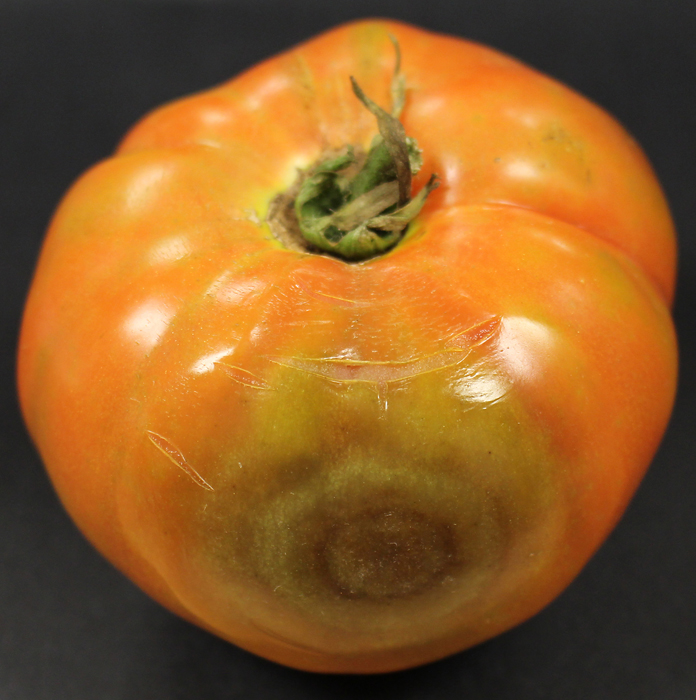 Figure 7. Buckeye rot (Phytophthora spp.). Note soft lesions with concentric brown rings.
Figure 7. Buckeye rot (Phytophthora spp.). Note soft lesions with concentric brown rings.Favorable Conditions
Buckeye rot develops during periods of warm, wet weather. Optimal temperatures for development are 65 to 80 °F and the spread of the pathogen occurs with splashing water and rain. The pathogen survives in the soil, and fruit near the soil are first infected. Wet and uncovered soils expose the lowest fruit to infection.
Late Blight
Causal agent: Phytophthora infestans
Symptoms
Late blight causes an irregular blight of the foliage and fruit rather than distinct spots (Figure 8). Leaf lesions start as small dark areas that expand rapidly until the leaf dies. In wet weather, gray to white fungal spores may cover the undersides of the lesions. Fruit lesions are dark and greasy in appearance, becoming rough and sunken (Figure 9). Secondary bacterial soft rot often develops. With prolonged cool and wet conditions, late blight spreads quickly and plants die in a few days.
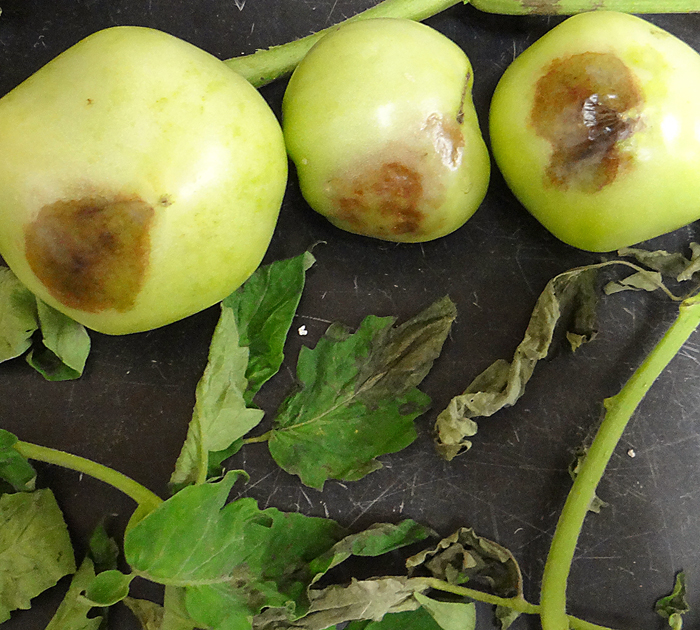 Figure 8. Late blight (Phytophthora infestans) lesions on tomato fruit, stems, and leaves. Lesions on leaves are irregular and quickly kill entire leaves.
Figure 8. Late blight (Phytophthora infestans) lesions on tomato fruit, stems, and leaves. Lesions on leaves are irregular and quickly kill entire leaves.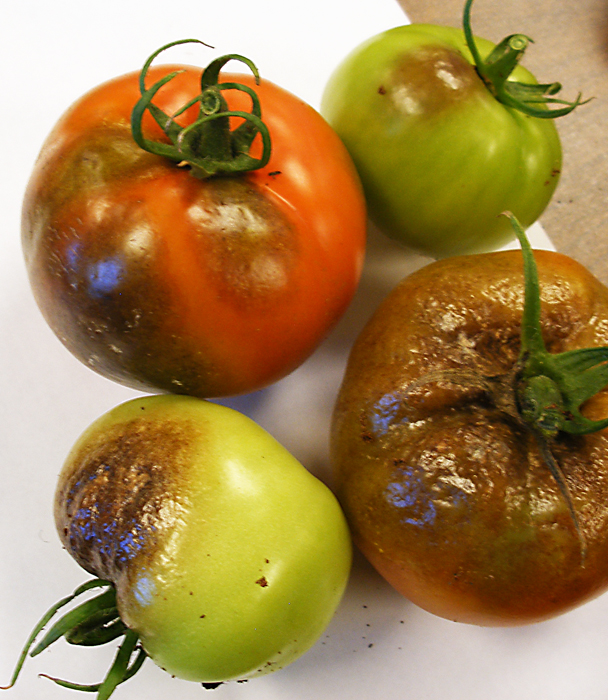 Figure 9. Late blight (P. infestans) lesions on tomato fruit. Older lesions become rough and sunken.
Figure 9. Late blight (P. infestans) lesions on tomato fruit. Older lesions become rough and sunken.Favorable Conditions
Late blight spreads in cool, wet weather and is an occasional problem in the northern portions of Georgia when summers are unusually cool and wet.
Anthracnose
Causal agent: Colletotrichum spp.
Symptoms
The primary damage caused by anthracnose is fruit rot that develops as the fruit ripens. Infections start as a small, circular, slightly sunken lesion that gradually expands. The skin over the lesion often remains intact and the flesh in the lesion is often lighter in color. As the lesion enlarges, concentric rings of dark spore-producing structures develop which produce slimy masses of salmon-colored spores during wet weather (Figure 10).
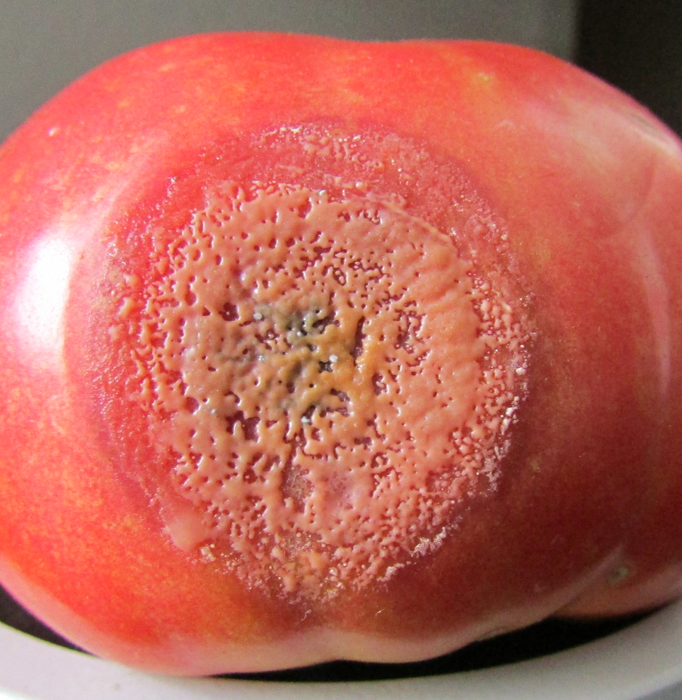 Figure 10. Anthracnose (Colletotrichum spp.) on fruit. Lesions are sunken with concentric circles. In wet conditions, fungi produce spores in an orange slime.
Figure 10. Anthracnose (Colletotrichum spp.) on fruit. Lesions are sunken with concentric circles. In wet conditions, fungi produce spores in an orange slime.Favorable Conditions
The pathogen survives in plant debris and as long-lived, hardened microsclerotia in the soil. Warm (68 to 85 °F), wet conditions are needed for the disease to develop. Spores are splashed onto the fruit from the soil or other infected fruit. Fruit close to the ground may be first infected.
Tomato Spotted Wilt Virus
Causal agent: Tomato Spotted Wilt Virus
Symptoms
The first symptoms occur on the youngest leaves with bronze to brown blotches and ringspots (Figure 11). Over time, the plant becomes stunted and the foliage often droops and looks wilted. If plants are infected when young, no fruit will be produced. On older infected plants, the fruit develops yellow ringspots (Figure 12). As the fruit ripens, the ringspots often turn brown resulting in irregular dark lesions on the fruit (Figure 13). Infected plants occur randomly in the planting. Small plant-feeding thrips carry TSWV from plant to plant.
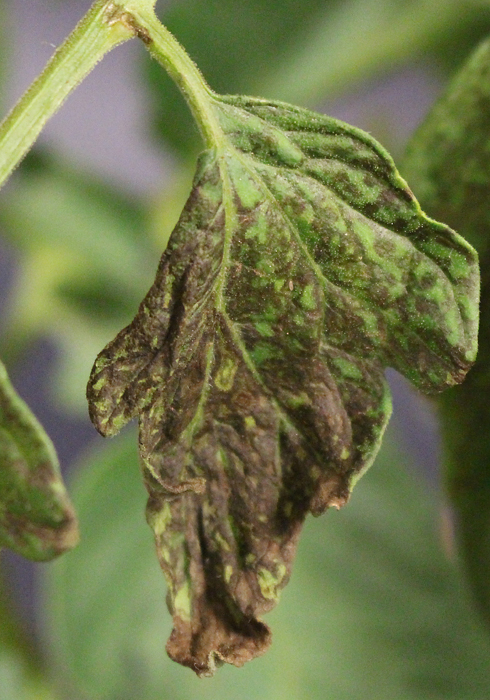 Figure 11. Leaf symptoms of tomato spotted wilt virus on tomato leaves. Dark lesions and ringspots appear on the youngest leaves a few weeks after infection.
Figure 11. Leaf symptoms of tomato spotted wilt virus on tomato leaves. Dark lesions and ringspots appear on the youngest leaves a few weeks after infection.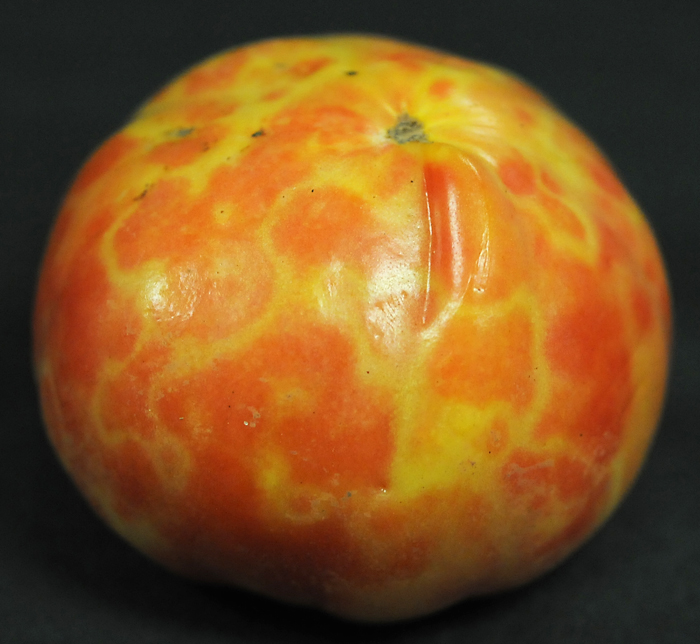 Figure 12. Ringspot symptoms from tomato spotted wilt virus on fruit.
Figure 12. Ringspot symptoms from tomato spotted wilt virus on fruit.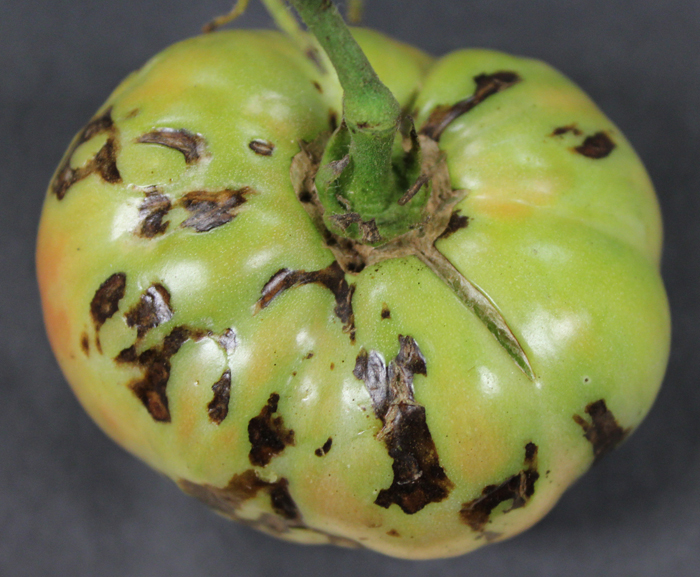 Figure 13. Older ringspot symptoms on fruit from tomato spotted wilt virus. Ringspots develop into dead areas.
Figure 13. Older ringspot symptoms on fruit from tomato spotted wilt virus. Ringspots develop into dead areas.Favorable Conditions
The virus survives in many different weeds and plants. Most infections occur in late spring when the thrips become active in large numbers. Infections can be hard to prevent, especially if there are weedy areas nearby. The virus is more severe in warm climates such as southern Georgia and is usually sporadic in northern Georgia.
Soilborne Diseases
Fusarium Wilt
Causal agent: Fusarium oxysporum f.sp. lycopersici
Symptoms
The disease usually starts after the plant starts to produce fruit. The leaves turn yellow and may start to wilt during the heat of the day. Symptoms may first occur on only one side of the plant, but eventually all the leaves turn brown and the entire plant dies. The brown leaves cling to the plant although the petioles and stems remain green for a time and fruit may continue to ripen (Figure 14). Death can occur rapidly under warm conditions.
The fungus clogs the water-conducting xylem of the plant, and a browning of the vascular tissues can be observed inside the lower stems of affected plants (Figure 15). Symptoms may be confused with Verticillium wilt, although Verticillium does not occur in Georgia.
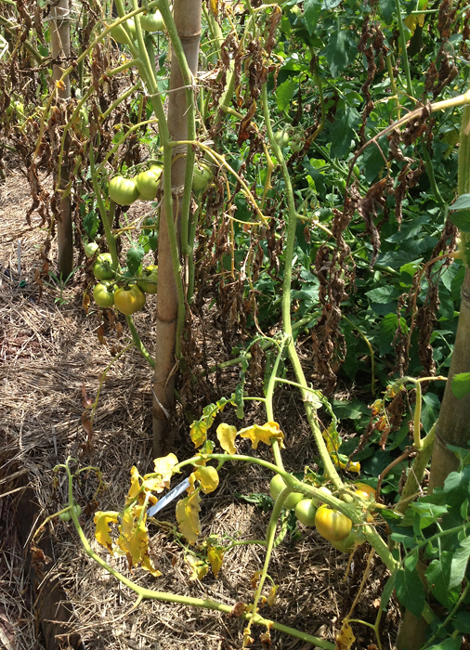 Figure 14. Fusarium wilt symptoms on tomato. Note the browning and death of leaves although stems often remain green for a time and green fruit continues to ripen.
Figure 14. Fusarium wilt symptoms on tomato. Note the browning and death of leaves although stems often remain green for a time and green fruit continues to ripen.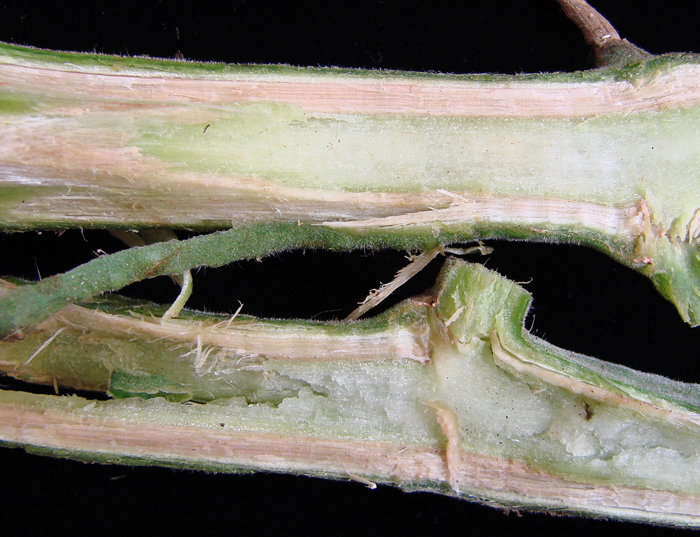 Figure 15. The browning of xylem tissues in a tomato stem just above the soil line is diagnostic of Fusarium wilt.
Figure 15. The browning of xylem tissues in a tomato stem just above the soil line is diagnostic of Fusarium wilt.Favorable Conditions
Fusarium wilt is primarily a southern disease and infects during warm weather (84 °F and higher). This fungus only infects tomatoes and can survive in the soil for years waiting for tomato roots. Nutrient imbalances, poor soil conditions, or low pH all favor infection. Fusarium wilt is more common in soils with plant parasitic nematode infestations, and the fungus enters the roots through the wounds created by nematode feeding. Most hybrid tomatoes have some resistance to the disease.
Southern Blight
Causal agent: Sclerotium rolfsii (Agroathelia rolfsii)
Symptoms
The foliar symptoms of southern blight look like Fusarium wilt, with the leaves quickly turning yellow and then brown. Death can occur within a few days, and the foliage quickly browns (Figure 16).
Southern blight can be differentiated from Fusarium by the rapid browning and death of the stem at the soil line. Under moist conditions, a white cottony growth develops on the lower stem near the soil line and can extend several inches up the stem. After a few days, numerous tan to reddish-brown small round sclerotia (fungal survival structures) will appear on the white growth (Figure 17). The fungus also will attack fruit lying on the ground, resulting in fruit rot with white fungal growth.
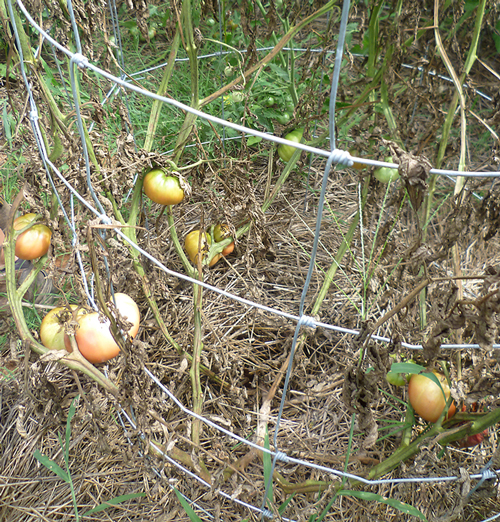 Figure 16. Southern blight (Sclerotium rolfsii) causing death of tomato plant. Symptoms are like Fusarium wilt, with leaves quickly turning brown although stems remain green for a time.
Figure 16. Southern blight (Sclerotium rolfsii) causing death of tomato plant. Symptoms are like Fusarium wilt, with leaves quickly turning brown although stems remain green for a time.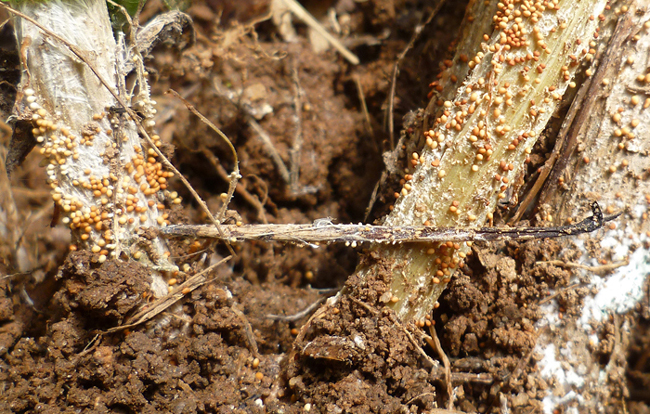 Figure 17. Diagnostic features of S. rolfsii on lower stem of infected plant. Note death of the stem at the soil line with white fungal growth and round sclerotia.
Figure 17. Diagnostic features of S. rolfsii on lower stem of infected plant. Note death of the stem at the soil line with white fungal growth and round sclerotia.Favorable Conditions
The southern blight pathogen produces numerous sclerotia that survive in the soil for many years until a plant host grows near them. The pathogen can infect many different host plants but most commonly tomatoes, peppers, and beans. Sclerotium is a hot-weather pathogen, and infections occur when conditions are humid and hot (86 to 95 °F). Wet and/or poorly drained soils favor the development of the disease.
Southern Bacterial Wilt
Causal agent: Ralstonia solanacearum
Symptoms
Bacterial wilt disease is most commonly found on tomatoes, although other solanaceous plants such as potato, pepper, and eggplant also may be infected. The first symptom is a sudden and permanent wilting of the leaves, even when there is adequate soil moisture (Figure 18). Wilted leaves do not immediately turn brown as seen with Fusarium wilt and southern blight. The entire plant can wilt and die in a few days with brown to black lesions developing on stem surfaces and a dark, wet rot developing inside the lower stems (Figure 19).
Similar to Fusarium, the bacterium invades and clogs the water-conducting elements of the plant. When the lower stem of an infected plant is split open, vascular tissues are dark. The lower stem eventually develops a dark wet rot (Figure 20).
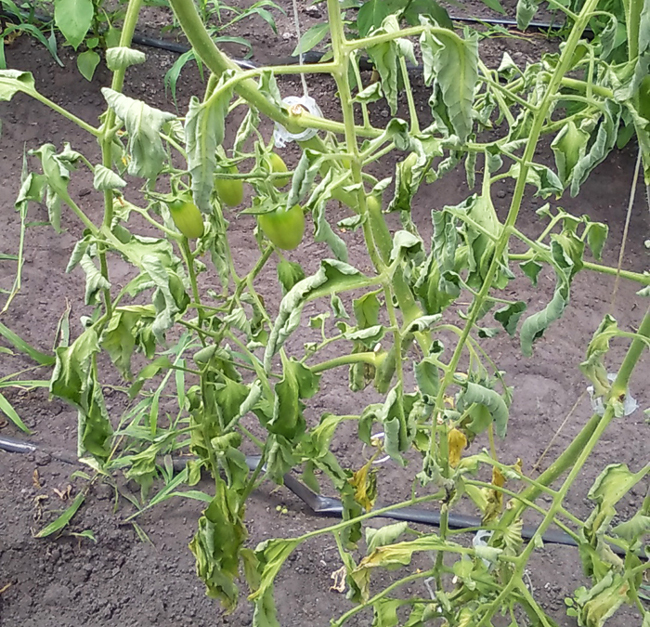 Figure 18. Early symptoms of bacterial wilt (Ralstonia solanacearum) on tomato. Note the lack of browning on the wilted leaves.
Figure 18. Early symptoms of bacterial wilt (Ralstonia solanacearum) on tomato. Note the lack of browning on the wilted leaves. Figure 19. Advanced symptoms of bacterial wilt (R. solanacearum). Note elongated darkened lesions developing on stems.
Figure 19. Advanced symptoms of bacterial wilt (R. solanacearum). Note elongated darkened lesions developing on stems.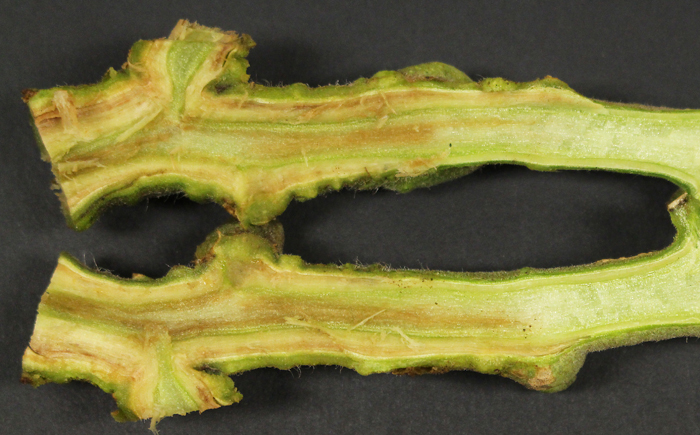 Figure 20. Bacterial wilt (R. solanacearum) vascular discoloration in lower stem. Symptoms darken and extend into central pith of stem as disease advances.
Figure 20. Bacterial wilt (R. solanacearum) vascular discoloration in lower stem. Symptoms darken and extend into central pith of stem as disease advances.Favorable Conditions
Bacterial wilt is a disease that occurs mainly in warm subtropical to tropical areas, including Georgia. The bacterium survives long-term in the soil. Warm, moist soils are best for bacterial survival. Infections are more frequent when temperatures are high (~80 to 95 °F), and the soil is wet and dense. Wounds on the roots from transplanting, equipment, and nematode and insect feeding provide entry points for infection.
Root Knot Nematode
Causal agent: Meloidogyne species
Symptoms
The root-knot nematode (RKN) is a minute plant parasitic roundworm found in most soils. While there are several types of plant parasitic nematodes, RKN is often the most serious in vegetable production. The nematode enters the root and creates a feeding site that results in a visible gall or swelling. As the number of galls increases, the roots become deformed with a lack of secondary roots (Figure 21). The galls reduce root efficiency and the aboveground parts of the plant gradually decline and become unproductive.
RKN feeding also will increase the incidence and severity of other soilborne diseases such as Fusarium and bacterial wilt.
 Figure 21. Root-knot nematode (Meloidogyne spp.) galls on roots. Note the lack of secondary roots.
Figure 21. Root-knot nematode (Meloidogyne spp.) galls on roots. Note the lack of secondary roots.Favorable Conditions
While RKN tends to be most abundant and damaging in the warm, sandy soils of the Coastal Plain region, RKN and other plant pathogenic nematodes occur throughout Georgia. RKN feeds on the roots of many different plants, including most vegetables. Repeated planting of susceptible plants in the same site each year will lead to increasing nematode numbers and damage.
Some cultivars of tomato have resistance to RKN. There are no chemical treatments for RKN for the home garden and keeping RKN numbers low takes an integrated approach of soil improvements and rotation to nonhost crops (see Krueger et al. in the references section for more details).
Tomato Disease Management
As with all plant diseases, management is based on prevention. Plant diseases are difficult to manage once there are significant symptoms. Good growing practices are a must for producing healthy tomatoes and will prevent many disease problems. Choose a sunny, open site with good airflow. Low spots or areas surrounded by vegetation will be more humid and encourage disease.
Most fungal and bacterial pathogens need wet conditions to infect and cause disease. Drip or hand irrigation is preferable to overhead irrigation. If using sprinkler irrigation, water early in the morning on sunny days to decrease the time when leaves are wet. Deep, less frequent irrigation is preferable to frequent shallow irrigation.
Adequate spacing of plants, staking, and pruning to open the leaf canopy all are important measures for increasing air circulation. High tunnels should be well-ventilated and fans used as needed to reduce humidity. Mulching or covering the ground will prevent pathogens from splashing up onto the leaves and will help keep the soil evenly moist.
Most fruit and foliar tomato diseases survive from one season to the next on infected plant tissues that fall to the ground during the growing season. Crop residues, including roots, should be removed and destroyed at the end of the season. Some pathogens such as Alternaria, Septoria, and especially bacterial pathogens can be carried on seeds from plants exposed to pathogens during the growing season. Obtain seed from reputable seed companies. If saving seed, avoid using fruit from diseased plantings.
Soilborne pathogens survive in the soil and infect through the roots, lower stem, or plant parts close to the ground, causing root, fruit, and lower stem rots, or systemic vascular wilts. Minimize soilborne diseases by choosing sites with well-drained soils, rotating between crop families, improving soil quality with organic matter, and reducing the frequency of irrigation so that the soil around the plant is not constantly wet.
A 3-year rotation away from tomatoes and related crops (eggplants, peppers, or potatoes) is optimal and helps distance the plants from the sources of disease. Greenhouses and high tunnels should be thoroughly cleaned and rotated away from tomatoes and related crops whenever possible. Healthy plants are better able to resist disease, so good soil preparation is essential with adequate levels of organic matter and an optimum balance of nutrients and pH (based on a soil test).
Many tomato cultivars have some resistance to one or more diseases and this information can be found in seed catalogs. Pesticide recommendations for particular diseases can be found in the home or commercial editions of the Georgia Pest Management Handbook. Pesticides are not effective unless used preventively (before the disease has spread) and correctly based on an accurate diagnosis and recommendation. Cultural practices and resistance can be sufficient to avoid using pesticides in home gardens.
References
Davis, R. M., Pernezny, K., & Broome, J. C. (Eds.). (2012). Tomato health management. APS Press. https://doi.org/10.1094/9780890544884
Jones, J. B., Zitter, T. A., Momol, T. M., & Miller, S. A. (Eds.). (2016). Compendium of tomato diseases (2nd ed). APS Press. https://doi.org/10.1094/9780890544341
Krueger, R., McSorley, R., & Grabau, Z. (2022). Nematode management in organic agriculture (Publication No. ENY-058). University of Florida/IFAS Extension. http://edis.ifas.ufl.edu/ng047
The original version of this manuscript was written by Mila Pearce, former IPM homeowner specialist, Department of Plant Pathology.
This publication was rewritten and expanded by Elizabeth Little, retired associate professor and Extension plant pathologist, Department of Plant Pathology. All images also were taken by Elizabeth Little. Bhabesh Dutta is the current Extension contact for questions about this publication.
Status and Revision History
Published on Aug 15, 2005
Published on Feb 10, 2009
Published on May 05, 2009
Published with Major Revisions on Mar 08, 2024


























































